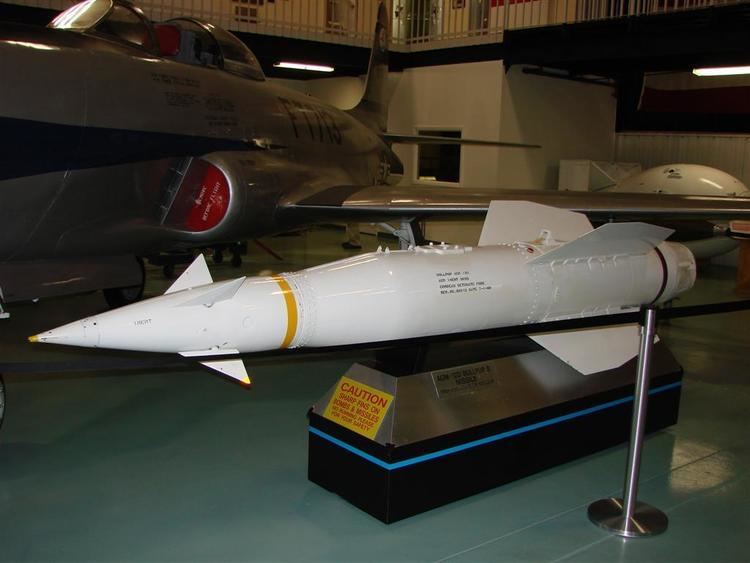 | ||
Type Air-to-ground command guided missile In service ASM-N-7 1959–1970sASM-N-7A/AGM-12B 1965–1970s Manufacturer Martin Marietta, W.L. Maxson | ||
The AGM-12 Bullpup is an air-to-ground missile which was used on the A-4 Skyhawk, A-6 Intruder, F-105 Thunderchief and F-4 Phantom among others. It has been superseded by more advanced weapons, notably the AGM-62 Walleye and AGM-65 Maverick.
Contents
Design
The Bullpup was the first mass-produced air-surface command guided missile, first deployed by the United States Navy in 1959 as the ASM-N-7, until it was redesignated the AGM-12B in 1962. It was developed as a result of experiences in the Korean War where US airpower had great difficulty in destroying targets which required precise aiming and were often heavily defended, such as bridges.
Although they could hit targets fairly accurately, pilots found that the warhead of the AGM-12 was not very effective against the massive concrete structures of large bridges in North Vietnam. However, in at least one specific instance, the Bullpup proved its value when a pilot guided one into the cave entrance of a large ammunition storage facility dug into a mountain. Previous attacks with conventional, unguided ("dumb") bombs had been ineffective against the mountain surface, but when the Bullpup missile struck the entrance to the underground facility and detonated, it set off a huge secondary explosion of the stored ammunition.
Operation
The Bullpup had a Manual Command Line Of Sight guidance system with roll-stabilization. In flight the pilot or weapons operator tracked the Bullpup by watching a flare on the back of the missile and used a control joystick to steer it toward the target using radio signals. It was initially powered by a solid fuel rocket motor, and carried a 250 lb (110 kg) warhead.
After launching the Bullpup, best accuracy was maintained by continuing to fly the same track, so that the pilot could sight down the smoke trail and steer the missile from directly behind as much as possible. Unfortunately, one problem quickly discovered by pilots in Vietnam was that gunners on the ground could simply fire at the smoke trail of the missile's flare and have a fairly good chance of hitting the aircraft that had launched—and was still guiding—the missile. Thus, to try to protect their own aircraft, the pilot would "jig" slightly off of the missile's path and hopefully avoid the anti-aircraft fire.
Variants
Later versions of the missile included upgrades such as a larger 1000 lb (450 kg) warhead, improved rocket motors, and improved guidance—the latter originally developed as part of the GAM-79 White Lance project for an improved, enlarged Bullpup for the US Air Force—and, in one late version, the ability to carry a nuclear warhead, also pioneered as part of the GAM-79 project.
The weapon was phased out of US service in the 1970s but was still used by other countries much later. Some militaries currently still use some as inert practice weapons.
Current operators
Taiwan (Republic of China)
